Imbros Gorge: History, Map, Hiking and Car Rental

Imbros Gorge is an 11 km long canyon located near Chora Sfakion in southern Crete, Greece. Imbros Gorge runs parallel to the famous Samaria Gorge. The picturesque scenery and relatively easy hiking trail make Imbros Gorge suitable for families and those looking for a shorter canyon hike than Samaria.
The entrance to the hiking trail is near the small mountain village of Imbros, around 57 km southeast of the city of Chania. Imbros village marks the northern entrance and Komitades village marks the southern exit of the 11 km long Imbros Gorge.
Imbros Gorge has an interesting history. In the past, it was part of the main route connecting the north and south of Crete before roads were built. Remnants of the old stone paved mule trail can still be seen inside the gorge. During World War II, thousands of British soldiers used Imbros Gorge to evacuate from Crete to Egypt after losing the Battle of Crete. There are also signs of ancient battles between Christians and Ottoman Turks during the 19th century Turkish occupation of Crete.
Yes, one can rent a car to visit Imbros Gorge. Car rental services on Crete offer daily, weekly and monthly rental periods. For a week-long trip, expect to pay between €150 and €350 depending on the type of car and rental company. For a day trip, costs range from €20 to €70. Rental location, mileage limits and vehicle type influence price. Economy cars are generally the most affordable option. When renting a car in Crete, key factors to consider include: Insurance coverage options, Driver age restrictions, Documents needed like license and credit card, Car type based on terrain and passenger capacity, SUVs generally provide ground clearance and capacity for the roads to Imbros Gorge. The Nissan X-Trail, Peugeot 2008 and Jeep Renegade are good SUV options.
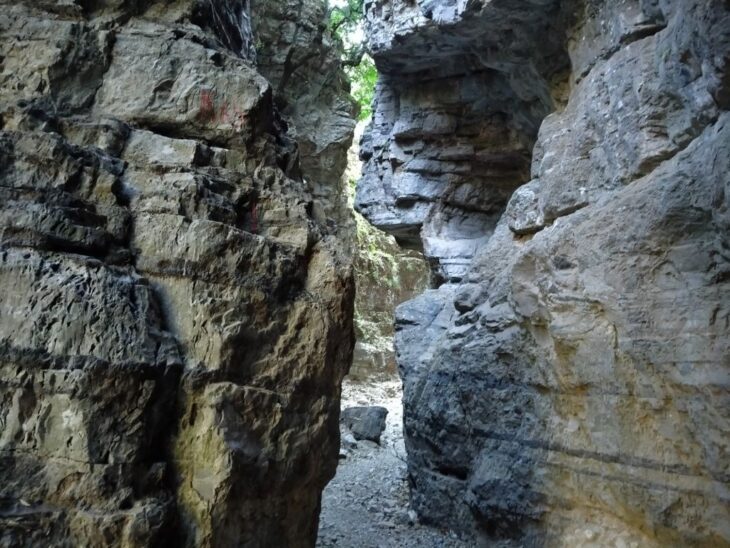
The actual Imbros Gorge hiking trail is 8 km long and takes around 2-3 hours. The trail descends 600 meters from Imbros village to Komitades village and involves some narrow, scenic passages. Proper footwear is recommended for the rocky terrain. The hike is open year-round but best done in spring or autumn. Summer can be hot and winter brings risks of falling rocks and flash floods. Entry fees apply from May to October. Imbros Gorge offers beautiful natural scenery, relatively easy hiking, an interesting history and a good family-friendly alternative to the crowded Samaria Gorge. Visitors describe Imbros Gorge as a scenic and memorable outdoor adventure.
What is Imbros Gorge?
Imbros Gorge is an 11 km long canyon located near Chora Sfakion in southern Crete, Greece. It is the second most popular gorge for hiking after Samaria Gorge. The picturesque scenery and relatively easy hiking trail make Imbros Gorge suitable for families and those looking for a shorter canyon hike than Samaria. The gorge runs parallel to the famous Samaria Gorge and is located in the Chania regional unit in southern Crete. The entrance to the hiking trail is near the village of Imbros, around 57 km southeast of Chania. The gorge ends close to the small village of Komitades, near the coastal town of Chora Sfakion.
Where is Imbros Gorge?
The Imbros Gorge is situated in the Chania regional unit in the southern part of Crete, Greece. More specifically, the starting point for the hike through the gorge is located close to the small mountain village of Imbros. This village is approximately 57 km to the southeast of the city of Chania if you’re driving there from Chania. The gorge itself runs in a southward direction, descending down from the elevated village of Imbros towards the sea. At the southern end, the hike exits near the tiny seaside village of Komitades, not far from the better known town of Chora Sfakion along Crete’s southern coastline. So in summary, Imbros village marks the northern entrance and Komitades village marks the southern exit of the 11 km long Imbros Gorge.
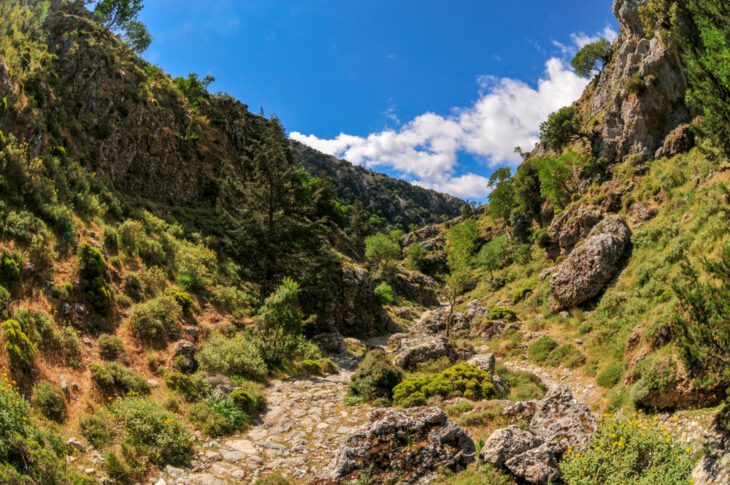
What is the archaeology of Imbros Gorge?
Imbros Gorge has an interesting archaeological and historical background. In the past, before roads were constructed in this part of Crete, the gorge used to be part of the main route that connected the northern and southern parts of the island. You can still see remnants of the old stone paved mule trail that runs through the gorge if you look closely while hiking. The gorge also played an important role during World War II when thousands of British soldiers passed through it to evacuate from Crete to Egypt after the Battle of Crete was lost. In addition, there are signs of ancient battles that took place in the gorge between Christians and Ottoman Turks during the Turkish occupation of Crete back in the 19th century. A memorial plaque can be found commemorating Cretan fighters who died defending the gorge against the Ottoman troops.
How was Imbros Gorge formed?
Geologists believe Imbros Gorge was formed over millions of years by natural processes shaping and carving the land. The gorge was created by the action of rivers and mountain streams eroding channels through the layers of limestone and clay that make up the geography of Crete. Experts who have studied Imbros Gorge say that tectonic shifts slowly caused the land to fracture and fault millions of years ago. This formed steep ravines and passageways. Water gradually widened the cracks and crevices through erosion, carving a winding gorge between the high cliffs. The river Imbros once ran through the gorge, carving the passage deeper through the landscape over aeons. Earthquakes and shifting geology continued altering the topography, resulting in the dramatic and rugged gorge visible today. Geologists like Professor Costas Xenophontos of the University of Athens have extensively researched the rock formations and river systems that developed Imbros Gorge over geological timescales. Their dating and landscape analysis reveals the natural sequence of events that shaped this iconic Cretan landform. Ongoing study of erosion patterns, rock deposits and fossil evidence provides insights into how tectonic forces and water carved out Imbros Gorge millions of years ago to create its breathtaking terrain. It serves as a timeline documenting Crete’s long and dynamic geological history.
How is the Imbros Gorge preserved?
Imbros Gorge is preserved through special environmental protections and regulations to maintain its natural state. The Greek government has designated much of the gorge and surrounding area as a national park. Laws strictly control development, grazing, farming and other activities that could degrade the landscape. National park rules prohibit new construction, road building and commercial uses. These laws help conserve the gorge’s landforms, ecosystems and wildlife. Local organisations like the Imbros Gorge Management Bodywork to monitor conditions in the gorge according to conservation science. They track wildlife populations, protect endemic plants and document any changes to the terrain. Their data informs protective policies and rehabilitation efforts. Guides and rangers in Imbros Gorge educate visitors on safety and avoiding detrimental impacts. Boardwalks and designated trails control foot traffic through sensitive areas. Fines are issued for offences like littering, graffiti or unauthorised campfires. Preservation is also promoted through UNESCO’s recognition of the gorge’s outstanding natural value. This strengthens international cooperation and resources to maintain Imbros Gorge for future generations. Ongoing stewardship by Greek authorities, conservation groups and the public aims to keep its archaeological and ecological integrity intact.
How does the Imbros Gorge map look?
Below is an image of the map of Imbros Gorge.
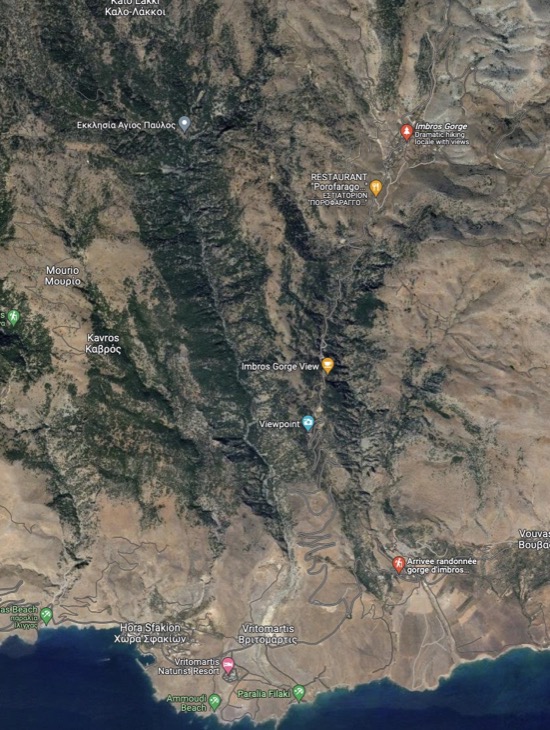
What are the hiking routes in Imbros Gorge?
There are three main hiking routes through Imbros Gorge. Firstly, there is the Arai to Komitades route. This is the most popular and accessible trail, suitable for novice hikers. The path starts at the village of Arai and winds 8km down through the gorge to Komitades village. The trail showcases stunning views between the towering rock walls and passes by landmarks like the Chapel of Saint Nicholas. Secondly, there is the longer Arai to Milia route. This challenging 15km trail follows the gorge down to the abandoned village of Milia. Extra fitness is needed for steep sections and parts that require scrambling over boulders. Dramatic lookout points along this hike make it rewarding. Finally, there is the circuitous Komitades to Sfakia route. This trail goes up the Samaria Gorge, crosses a mountain pass, then descends back down through Imbros Gorge to the coastal village of Sfakia. Good physical conditioning is vital for the 20km distance and elevation changes. But the scenery makes this a world-class hike. Whichever direction hikers take, Imbros Gorge offers magnificent experiences walking through the chasm carved out by nature. Careful preparation and responsible practices help protect the gorge’s special hiking trails for future generations.
How long is the hike to Imbros Gorge?
The total length of Imbros Gorge from end to end is approximately 11 km. However, the section inside the gorge that is commonly hiked by tourists is around 8 km long. Despite the length, the hike through the gorge is considered relatively easy, with a total descent of around 600 metres in elevation from the starting point to the exit. Most hikers take between 2-3 hours to complete the hike at a relaxed pace, allowing time for photographs and pauses to take in the scenery. The hike takes you through some narrow and visually impressive sections of the gorge along the way. So in summary, while Imbros Gorge is 11 km long, the hike covers 8 km and takes 2-3 hours for most walkers.
Do you need a guide to hike the Imbros Gorge?
No, a guide is not necessary for hiking through Imbros Gorge. It is permitted to do the hike independently without a guide leading the way. However, there are some advantages to hiking the gorge with a knowledgeable guide. The trail through Imbros Gorge is well-defined and straightforward to follow in most parts. Proper route finding does not generally require assistance navigating from start to finish. The main pathway is walked by thousands of visitors annually. However, a local guide can provide context and information to enhance the hiking experience. They call attention to highlights along the trail that hikers may otherwise miss. Guides also offer safety advice for difficult sections and share stories about the gorge’s history, geology and ecology. Hiring an authorised guide provides access to restricted areas in Imbros Gorge off the recognised footpaths. They lead hikers to hidden caves, remote ruins and less accessible lookout points. These extras make a guided hike more in-depth and memorable. Guides are not mandatory for visiting Imbros Gorge and it is possible to do the hike independently. But hiring a knowledgeable guide certainly enriches the adventure and allows seeing more beyond the standard trail. Guided or not, responsible practices help preserve Imbros Gorge’s special natural beauty.
What are the risks in hiking Imbros Gorge?
Hiking through Imbros Gorge poses certain risks for which hikers should assess and prepare. While beautiful, the gorge’s remote setting and challenging terrain make safety a priority. Restrictions exist on when the gorge can be accessed. It is closed from November to April due to the danger of flash flooding in the rainy season when water levels rapidly rise. Hiking is only permitted during the drier spring and summer months. The trail involves rocky and uneven ground sections that increase the chances of slips or ankle injuries. Steep drop-offs close to the path mean losing one’s footing could lead to serious falls. Hikers must be sure-footed and cautious. Dehydration and overheating are hazards due to minimal shade and the physical demands of the hike. Drinking plenty of water is vital, especially in hot conditions. Proper footwear, sun protection and covering exposed skin reduces risks. Periodic rockfalls mean hikers should be alert to potential falling stones dislodged from above. Wearing a helmet safeguards against loose debris. Avoiding lingering under overhangs or cliffs helps minimise risk. Having emergency supplies and notifying others of one’s plans provides precaution. Overall, preparation and prudence help mitigate risks when exploring Imbros Gorge.
What are the most important facts about Imbros Gorge?
Listed below are the most important facts about Imbros Gorge:
- Length: The total length of the gorge is 11 km, but the commonly hiked section is 8 km long.
- Difficulty: The difficulty level of the hike is relatively easy overall, making it suitable for families and amateur hikers.
- Terrain: The terrain consists of a rocky path and riverbed inside the gorge. Proper footwear is recommended.
- Highlights: Highlights include very narrow passages, spectacular natural views, interesting historical sights and a lack of crowds compared to Samaria Gorge.
- Entrance: Imbros Gorge is open year-round for hiking, but there is a small entrance fee required from May to October.
When is the best time to visit Imbros Gorge?
The ideal time to visit Imbros Gorge for hiking is in springtime, particularly April and May, when the weather is pleasant and mild and there is lush vegetation visible inside the gorge. Late autumn, in October and November, is another good option when the summer crowds have thinned out and temperatures are cooler. Summer can be extremely hot in the gorge, but the shade from the canyon walls provides some relief. However, winter months can be wet and snowy, so it’s best to avoid the gorge after heavy rains because of the danger of falling rocks and flash flooding. In summary, spring and autumn are the best bets for ideal weather, with spring offering the most greenery and flowers to enhance the scenic views.
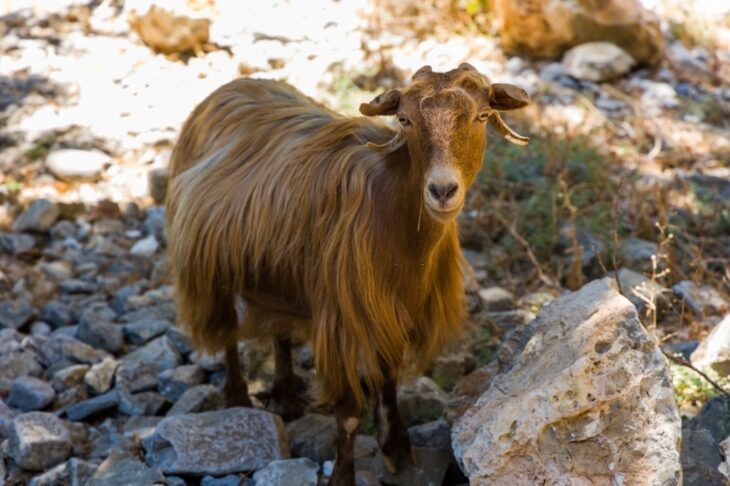
What are the things to bring when visiting Imbros Gorge?
Here is a definitive list of items to bring for a visit to Imbros Gorge, each accompanied by a brief explanation:
- Hiking Boots: A sturdy pair of hiking boots is essential for navigating the rocky and uneven terrain of the gorge.
- Water Bottle: Hydration is key, especially in the warmer months. A refillable water bottle is highly recommended.
- Backpack: A comfortable backpack must carry all essentials, including water, snacks and any additional clothing layers.
- Snacks: Energy bars, fruit or other portable snacks are advisable for maintaining energy levels during the hike.
- Map and Compass: While the trail is well-marked, having a map and compass can provide an extra layer of security.
- First Aid Kit: Basic first aid supplies such as band-aids, antiseptic wipes and pain relievers can come in handy for minor injuries.
- Sun Protection: Sunscreen, sunglasses and a hat are crucial for protecting oneself from the sun’s rays.
- Weather-appropriate Clothing: Depending on the season, one may need a light rain jacket or extra layers for warmth.
- Camera or Smartphone: For capturing the stunning scenery, a camera or smartphone with a good camera is advisable.
- Trekking Poles: These can provide additional support and balance, especially on steeper sections of the trail.
- Insect Repellent: To ward off any pesky insects, especially in the warmer months.
- Emergency Whistle: In case of an emergency, a whistle can be used to alert nearby hikers or rescue teams.
- Headlamp or Torch: Although the hike is generally completed during daylight, having a light source can be useful in case one gets delayed.
- Multi-tool or Swiss Army Knife: For any unexpected situations requiring a tool, such as cutting a piece of rope or opening a bottle.
What are the nearby attractions in Imbros Gorge?
Listed below are the nearby attractions in Imbros Gorge:
- Chora Sfakion: Chora Sfakion is located a short drive from the gorge. Chora Sfakion is a quaint, traditional Cretan village that offers a glimpse into local life. Known for its beautiful beaches and charming tavernas, it’s a perfect spot for relaxation after a hike through the gorge.
- Gavdos Island: Gavdos Island is accessible by ferry from nearby ports. Gavdos Island is the southernmost point of Europe. It’s an idyllic destination for those seeking tranquillity and natural beauty, featuring pristine beaches and crystal-clear waters.
- Loutro: Loutro is a small and picturesque seaside village located in southern Crete, Greece. It is known for its tranquil and authentic atmosphere, making it a perfect destination for those seeking relaxation and a slower pace of life. The village is characterised by its whitewashed buildings and charming harbour, which adds to its charm. Loutro is situated about 96 kilometres away from Chania and it can be reached by a 2-hour drive from the main town. The name “Loutro” comes from the Greek word for “bath”, as there were ancient baths in the area. Overall, Loutro is considered one of the prettiest villages in Chania, offering a peaceful and idyllic setting for visitors to enjoy.
- White Mountain: White Mountain is also known as the Lefka Ori. These mountains provide a dramatic backdrop to the Imbros Gorge. They offer a range of hiking and mountaineering opportunities for those looking to extend their outdoor adventures. The White Mountains are also home to the famous Samaria Gorge, another hiking destination that is often compared to Imbros Gorge.
- Glyka Nera beach: Glyka Nera Beach is a remote beach on the southwestern coast of Crete. It is a splendid fine pebble beach that can only be accessed by foot or boat. Glyka Nera beach is known for its secluded and romantic atmosphere, as well as the dramatic surrounding scenery with high cliffs and clear freshwater springs that flow into the sea. The name “Glyka Nera” means “sweetwater”, which refers to the clear freshwater springs that flow through the small pebbles and into the sea. It is considered one of the hidden treasures of Crete, showcasing the unique beauty of the island.
- Aradena Gorge: Aradena Gorge is a stunning natural landmark located in the Sfakia region of southwest Crete. It is a deep and narrow gorge that stretches inland from the Libyan Sea. The gorge has a rich history and is known for its breathtaking beauty. It has been inhabited since ancient times, with evidence of human presence dating back to the Minoan period around 3000-2800 BC. The ancient city of Aradin, also known as Heradin or Iradin, was situated near the modern village of Aradena. The city thrived during various eras, including the Roman, Byzantine and Venetian periods. Today, Aradena Gorge is a popular destination for hiking enthusiasts who are drawn to its rugged terrain and stunning views. It offers a unique opportunity to explore the natural and historical wonders of Crete.
- Filaki beach: Filaki Beach is a naturist-friendly beach located on the south coast of Crete. It is managed by Vritomartis Cretan Naturist Resort. The name “Filaki” translates to “Prison” in Greek, which reflects its remote location. During World War II, the beach served as a hiding place for Allied soldiers evading capture by the Axis powers. Its rough and isolated nature made it an ideal spot for concealing their presence and carrying out covert operations. Filaki Beach became a refuge for resistance fighters and played a role in the resistance efforts against the Germans. Today, Filaki beach is a popular destination for swimming, snorkelling and spearfishing due to the depth and clarity of the sea.
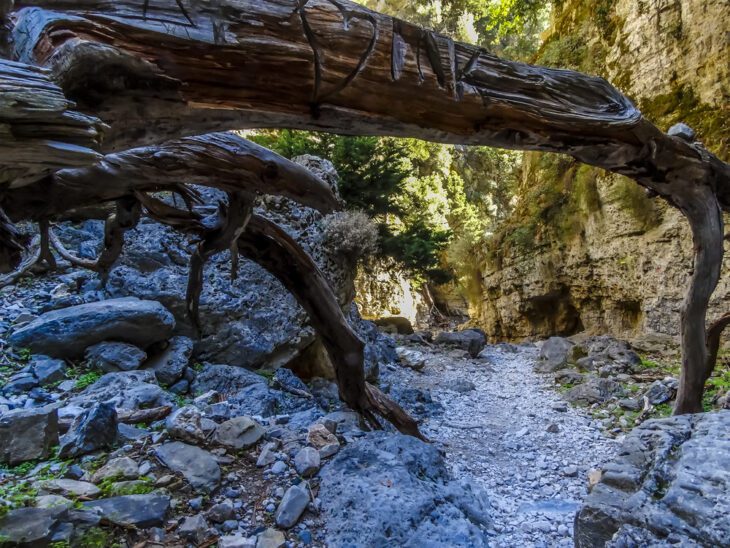
What is the contribution of Imbros Gorge in the tourism of Crete?
Imbros Gorge plays a significant role in the tourism industry of Crete. As one of the island’s most accessible and family-friendly gorges, Imbros Gorge is a major draw for tourists of all ages and hiking abilities. Its location, relatively close to popular towns and resorts, makes it an easy day trip for visitors in various parts of Crete. The gorge is often promoted as a less crowded and less strenuous alternative to the more famous Samaria Gorge, making it appealing to those seeking a more relaxed hiking experience. The gorge’s historical significance, having served as an escape route for Allied soldiers during World War II, adds an educational dimension to the hike. This aspect often attracts history enthusiasts and educational tour groups, thereby diversifying the tourist types. The gorge’s natural beauty, featuring unique plantations, contributes to Crete’s reputation as an eco-tourism destination. Many tour operators include Imbros Gorge in their itineraries, often in combination with other nearby attractions like Sfakia Village, Gavdos Island and the White Mountains, thereby boosting Crete’s overall tourism package. Imbros Gorge enhances Crete’s tourism by offering a versatile hiking experience that appeals to many tourists, from families and casual hikers to history buffs and nature enthusiasts. Imbros Gorge is considered one of most exciting gorges of Crete.
How to get to Imbros Gorge?
Listed below are the steps on how to reach Imbros Gorge:
- First, upon landing at Heraklion Airport, one should proceed to the arrivals hall, where car rental desks are located. Here, one can rent a suitable vehicle for the journey ahead.
- Second, after completing the necessary paperwork and obtaining the keys, one should locate the car in the designated airport parking area.
- Third, before leaving the airport, it’s advisable to set up a GPS or map application with the destination as Imbros Gorge. This ensures a smooth navigation experience.
- Fourth, one should exit the airport and follow the signs to merge onto the National Road E75, heading west towards Rethymno and Chania.
- Fifth, while on the E75, keeping an eye on the fuel gauge is a good idea. If needed, there are several petrol stations along the way where one can refuel.
- Sixth, as one continues on the E75, it’s important to stay alert for road signs indicating the exit for Imbros Village, which will appear after approximately 130 kilometres.
- Seventh, upon reaching the exit for Imbros Village, one should take this exit and follow the local roads that lead to the gorge.
- Eighth, after exiting the highway, it’s advisable to check the GPS or map application for the journey’s final stretch to ensure one is on the correct path.
- Ninth, upon arrival at Imbros Village, one can find parking areas near the entrance of the gorge. It’s recommended to secure a parking spot before starting the hike.
- Lastly, once parked, one can gather their hiking gear and proceed to the entrance of Imbros Gorge to begin their adventure.
Can you rent a car going to Imbros Gorge?
Yes, one can indeed rent a car to visit Imbros Gorge, a convenience facilitated by the well-established Crete Car Rental’ services available across the island’s major towns, airports and tourist hubs. Several factors come into play when choosing the right car for the journey. The type of vehicle is paramount; while a standard car is generally sufficient for a trip to Imbros Gorge, those planning on exploring more rugged terrains might opt for an SUV. Fuel efficiency is another consideration, particularly given the distance of the gorge from major urban centres. It’s advisable to opt for a reputable rental agency, often verified through customer reviews and ratings and to understand the insurance options available, perhaps opting for comprehensive coverage for added peace of mind. Equipping the car with GPS navigation can be invaluable, especially since the gorge is more rural. Booking the car in advance is recommended, especially during the tourist season when availability may be limited. Before departing, one should inspect the car for any pre-existing damage and ensure it’s documented in the rental agreement. Lastly, familiarising yourself with local driving laws and speed limits is essential for a safe and enjoyable trip to Imbros Gorge.
What are the factors to consider before renting a car in Crete?
Listed below are the factors to consider before renting a car in Crete:
- Insurance: Understanding the insurance options is crucial. Car rental services often offer various types of coverage, from basic to comprehensive. One should carefully read the terms and conditions to know what is covered and what isn’t and perhaps opt for comprehensive insurance for complete peace of mind.
- Driver’s Age: Age restrictions may apply when renting a car in Crete. Typically, the minimum age is 21 or 23, depending on the rental agency and there may also be an upper age limit. Some agencies charge an additional fee for drivers under a certain age.
- Driver’s Gender: While gender generally does not affect the ability to rent a car, it’s worth noting that all drivers, regardless of gender, should meet the agency’s requirements for age and driving experience.
- Car Type: The type of car one chooses can significantly impact the rental experience. For instance, a compact car may be more fuel-efficient and easier to park, while an SUV might be better suited for rugged terrains. One should consider the specific needs of the trip when deciding how to choose the right car to rent in Crete.
- Documents Needed for Renting a Car: Essential documents usually include a valid driver’s licence, a credit card in the name of the main driver and sometimes additional identification like a passport. Some agencies may also require an International Driving Permit, especially for non-European Union residents.
How much does a car rental in Crete cost?
The cost of renting a car in Crete varies considerably based on several factors, making it difficult to provide an exact definitive answer. For a week-long trip, one could expect to pay between €150 and €350, depending on the type of car and the rental company. For a day trip, the cost could range from €20 to €70, with luxury cars naturally costing more. Night trips may offer special rates, although this is not a standard practice across all rental companies. The rental location – be it an airport, city centre or tourist area – can also influence the price. The planned itinerary and any associated mileage limits could also affect the overall cost. While the number of persons doesn’t directly impact the rental rate, it may necessitate a specific vehicle type, influencing the final price. Economy cars are generally the most affordable, whereas SUVs, luxury cars and specialty vehicles come at a premium. It’s advisable to compare rates from various Crete car rental companies and scrutinise the terms and conditions, including insurance options, to comprehensively understand the total cost.
Is overnight car rental in Crete allowed?
Yes, overnight car rental in Crete is allowed. Crete Car Rental services generally offer a range of rental periods, including daily, weekly and even monthly options. The rental period usually starts from the time one picks up the car and until the car is returned. It’s essential, however, to carefully read the rental agreement to understand any terms or conditions that may apply to overnight rentals, such as additional charges or specific return times. By doing so, one can enjoy the flexibility of an overnight car rental while adhering to the rental agency’s policies.
Does renting a car provide you with the leisure you seek when travelling?
Yes, renting a car does provide one with the leisure one seeks when travelling. Renting a car offers unparalleled freedom and flexibility, allowing one to explore destinations at one’s own pace without the constraints of public transport schedules or tour group itineraries. Whether one wishes to take spontaneous detours to hidden beaches in Crete or spend extra time at a scenic overlook, having a rental car makes it possible. It also provides the convenience of door-to-door travel, eliminating the need to navigate public transport with luggage or wait for taxis. Additionally, a rental car can be a cost-effective option for groups or families, as the cost can be shared among multiple people. However, it’s important to note that the leisurely experience can be influenced by various factors such as local driving conditions, the type of car rented and familiarity with local driving laws. Nonetheless, for those who value freedom and flexibility, renting a car can significantly enhance the leisure aspect of travelling.
What do tourists say about Imbros Gorge?
Imbros Gorge offers hikers a beautiful nature experience. Reviewers praise the stunning scenery and landscapes inside the 11 km long canyon located near Chora Sfakion in southern Crete. Many describe the hike as spectacular yet easy enough for beginners and families. Even in summer, the gorge is pleasantly shaded by trees and canyon walls. The narrowest passage amazes people as it is just 1.6 m wide between 300 m high walls. Hikers say the rocky terrain requires sturdy shoes but is not too challenging. Walkers describe unique rock formations and fantastic photo opportunities. Reviewers recommend starting early to avoid crowds. At the end, the village of Komitades provides tavernas for meals. Reviewers say Imbros Gorge presents an excellent alternative to the more famous but crowded Samaria Gorge. People describe the experience as unforgettable and highly recommend a visit. Multiple reviewers state Imbros Gorge is scenic, beautiful and one of the highlights of their Crete visit.
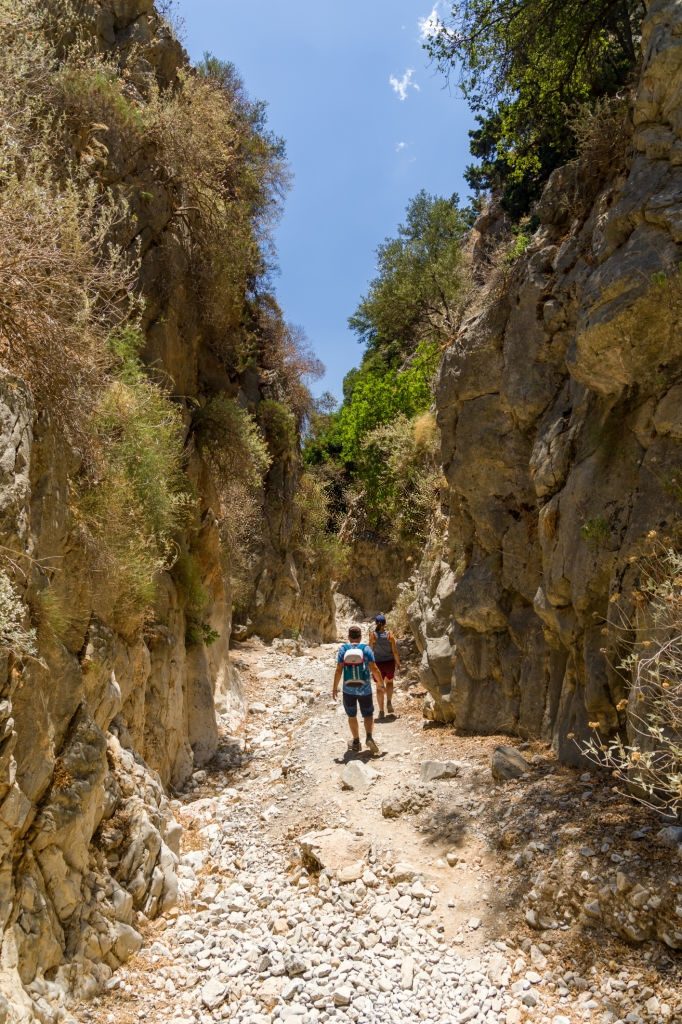
What are the nearest places to stay near Imbros Gorge?
Listed below are the nearest places to stay near Imbros Gorge:
- Sofia’s Lovely Rooms: Sofia’s Lovely Rooms is a small apartment complex in the village of Imbros that offers simple, budget-friendly accommodations a 10-minute walk from the gorge. The rooms have kitchenettes and private balconies overlooking the village.
- Villa Galatia: Located on the outskirts of Sfakia, this villa features self-catering apartments with mountain views, just a 5 km (3.2 miles) drive from Imbros Gorge. The apartments have fully equipped kitchens and a shared outdoor pool.
- Fagotto Art Residencies: Fagotto Art Residencies is located in the seaside village of Loutro, these apartments and studios double as artist residencies and are only 3 km (1.9 miles) from the entrance to the gorge. The residencies provide tranquil settings for artists to work and reflect.
Where to eat near Imbros Gorge?
Listed below are where to eat near Imbros Gorge:
- Despina: Despina is a charming local café known for tantalising the taste buds. Offering a delectable range of treats from smoky crepes and sumptuous mille-feuille to ethereal cheesecakes and comforting coffee, Despina has earned its stripes as a top-notch spot for scrumptious snacks, pastries and beverages.
- Koutelos: Koutelos is located in a historic stone building in Sfakia. Koutelos emphasises fresh seafood like grilled octopus and fish soups. They also serve meat dishes like Sfakian sausages and homemade cheese pies baked in a wood-fired oven.
- Yialos Wine Restaurant: Yialos sources top-quality ingredients from around Crete for creative versions of Greek dishes like sea bass carpaccio and lamb with stamnagathi greens. The wine list includes over 200 labels showcasing Greece’s wine regions.
Is it possible to hire a hiking guide in Imbros Gorge?
Yes, it is possible to hire a hiking guide in Imbros Gorge. Hiring a hiking guide for a trek through Imbros Gorge is an option many tourists consider, especially those unfamiliar with the area or prefer a more structured experience. Guides can offer valuable insights into the local flora, fauna and history, enhancing the overall hiking experience. Many tour companies and independent guides offer services specifically for Imbros Gorge, given its popularity as a hiking destination. These guides are often well-versed in the local geography and history, providing a richer, more informative experience. Additionally, having a guide can add an extra layer of safety, particularly for those who are less experienced hikers. Therefore, hiring a guide is a viable option if one wishes to have a more educational and secure hiking experience.
What kind of car should you rent when visiting Imbros Gorge?
When planning a trip to Imbros Gorge, the type of vehicle one chooses can significantly impact the overall experience. SUVs are generally a better choice as they offer ground clearance and more passenger and weight capacity. Companies like Rental Center Crete offer a range of SUVs catering to different budgets and needs. The Nissan X-Trail is an excellent choice, offering comfort, space and off-road capability. Its higher ground clearance is particularly advantageous on the uneven roads leading to the gorge and it can accommodate up to seven passengers, making it ideal for families or groups. Secondly, the Peugeot 2008 is another suitable option. This compact SUV is modern and often comes equipped with advanced safety features and amenities like air conditioning, enhancing the comfort of the journey. It can comfortably seat up to five passengers and has a commendable weight capacity for luggage and hiking gear. Lastly, the Jeep Renegade is known for its off-road capabilities and is well-equipped with modern amenities, making it another excellent choice for navigating the varied terrains en route to the gorge. It also has a substantial weight capacity and can seat up to five passengers. Given the features and capabilities of these vehicles, an SUV stands out as the most fitting choice for a trip to Imbros Gorge.
Can elderly people hike the Imbros Gorge?
Yes, elderly people can hike the Imbros Gorge. Imbros Gorge is often described as one of the more accessible gorges in Crete, requiring approximately 2-3 hours to complete the hike. The trail is well-marked and does not involve steep climbs or descents, making it suitable for individuals of varying fitness levels, including the elderly. However, it’s essential to note that the hike still involves walking on uneven terrain and may require moderate physical fitness. Elderly individuals who are in good health and are accustomed to walking or hiking should find the trail manageable. It’s advisable for older hikers to consult with their healthcare providers before undertaking the hike and to consider hiring a guide for added safety and assistance. Proper footwear and hydration are also crucial for a safe and enjoyable experience. Therefore, while the hike is generally considered to be of low to moderate difficulty, elderly individuals should take appropriate precautions to ensure their safety and comfort.
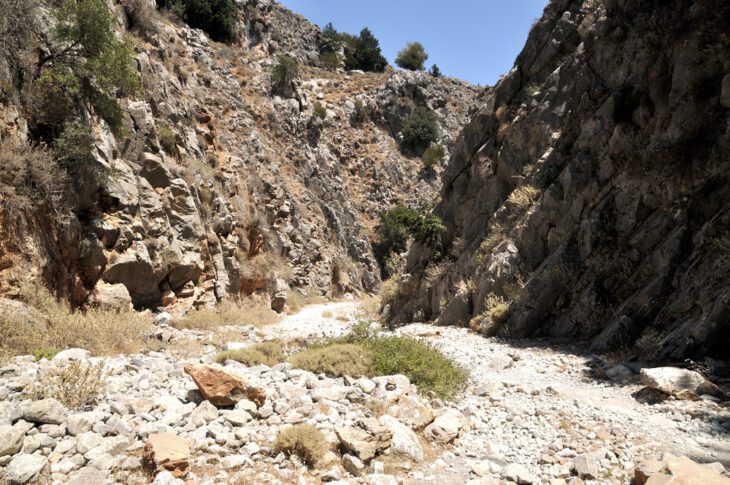
Can a couple hike the Imbros Gorge?
Yes, a couple can hike the Imbros Gorge. Imbros Gorge is an ideal destination for couples seeking a shared outdoor experience. The hike takes approximately 2-3 hours, making it a manageable day trip that allows ample time to enjoy the natural beauty and take photographs. The trail is well-marked and generally considered low to moderate difficulty, making it accessible for couples of varying fitness levels. The gorge offers stunning scenery, narrow passages and towering cliffs, providing couples a romantic and adventurous backdrop. Many couples find the hike to be a bonding experience as they navigate the trail and enjoy the natural surroundings together. The gorge is less crowded than its more famous counterpart, Samaria Gorge, offering a more intimate experience. Therefore, Imbros Gorge is a highly recommended option for couples looking for an adventurous yet manageable hike.
Is hiking Imbros Gorge child-friendly?
Yes, hiking Imbros Gorge is child-friendly. Imbros Gorge is often cited as a family-friendly hiking destination, suitable for children and adults. The trail is approximately 11 kilometres (6.84 miles) long and takes about 2-3 hours to complete, making it a manageable distance for younger hikers. The path is well-marked and does not involve steep or dangerous climbs, which makes it suitable for families with children. Parents often find that the gorge provides an educational experience for youngsters, offering opportunities to learn about the local plantation. Additionally, the gorge has historical significance, which can be an educational point of interest for older children. However, parents should take certain precautions, such as ensuring children wear appropriate footwear and carry sufficient water. Some families also opt to hire a guide for added safety and information.
Published on September 7, 2023














